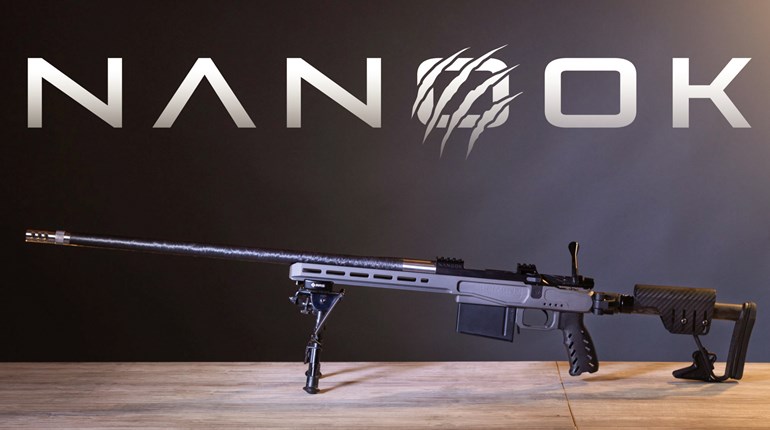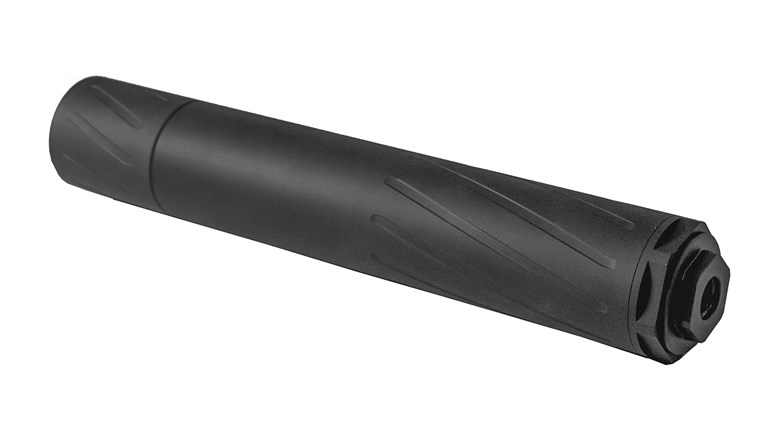
Nearly 85 years ago, Vasily Degtyaryov designed a radically new light machine gun for the Soviet Military. Called the DP-28 (Degtyaryov Pulemyot 1928), pulemyot being Russian for "machine gun," the gun operated via a long-stroke piston and employed a unique locking system using a short bolt group.
Composed of two pivoting lugs, or wing-like flaps on the sides of the bolt body, the rear portion of the top-mounted operating rod acted on the bolt carrier to not only move the bolt to and fro, but also to unlock and lock the bolt's lugs from their recesses in the sides of the receiver. The system used a non-rotating bolt, and went on to be used in a number of Soviet light machine guns—including the renowned RPD, which is still in service in many parts of the world.
In 1977, renowned firearms designer L. James Sullivan patented the "constant recoil" system used in his 5.56 NATO Ultimax 100 light machine gun. Constant recoil is a recoil-attenuation or mitigation system, which prevents the recoiling parts (bolt group) from stopping suddenly (bottoming out), and transmitting the force to the shooter. It is accomplished with a coil spring(s), and long bolt-group run-out.
Beginning around 2011, William Alexander, of Alexander Arms, began designing a revolutionary new semi-automatic rifle around what is arguably the world's best—and certainly among the most prolific—long-range rifle cartridge, the 8.58x69 mm, better known as the .338 Lapua Mag. Developed in 1989, it propels a 250-grain Lapua Scenar bullet at 3,000 fps. In ideal conditions, it has an effective range of 1,640 yards, or just 120 yards shy of a mile.

Called the Ulfberht .338, the name is in keeping with Alexander's long-time study and fondness for Anglo-Saxon mythology (think .50 Beowulf and 6.5 Grendel), as well as Viking lore. The Ulfberht was the famed Viking sword that was the pinnacle of technology in late-first-millennium Europe. Having characteristics shared with hundreds of other designs, the Ulfberht rifle is nonetheless unique unto itself, providing a glimpse into the mind of a brilliant engineer like Bill Alexander.
The Ulfberht was designed from the ground up as a static position, ultralong-range precision semi-auto. It operates via a long-stroke gas piston, with this element placed above the barrel with a reciprocating cocking handle. The operating rod and attached bolt group measures 23.9 inches and weighs 2.46 pounds on its own. The upper receiver group is comprised of a machined-steel receiver with a heavy pressed-steel top cover. A Mil-Spec 1913 steel rail runs the full length of the rifle's top.
Made of glass-filled polymer, the Ulfberht's lower receiver resembles that found on many contemporary semi-automatic rifles and feeds from a 10-round, double-column, double-position-feed magazine of the same material. The rifle will accept any AR-type pistol grip, and the buttstock is Magpul's PRS, which folds to the right on this .338 Lapua Mag. semi-automatic.
As you've probably guessed, the Ulfberht incorporates both the Degtyaryov locking system and constant recoil. The short bolt-carrier group allows ample room between it and the rear of the receiver, while the bolt carrier, which rides above the bolt, is attached to the operating rod in the front. It is hollow at the rear to house two opposite-wound coil springs, one inside of the other.
The cocking handle is attached to the carrier, and pulling it back causes its center cam to disengage from the two locking flaps, allowing them to pivot inward as the carrier begins to take the bolt with it against the dual recoil springs. On the way, the bolt cocks the AR-type hammer. In a departure from most other rifles, the Ulfberht's cocking handle rides in a channel that is above—and separate from—the ejection port.
Bolt travel is 5.5 inches before gradually stopping against the dual recoil springs. When pushed forward, the bolt and carrier go into battery, with the carrier camming the locking flaps back into their recesses in the receiver. The bolt uses a large Heckler & Koch-type extractor and sports two ejectors. It cannot be locked to the rear. The manual safety works much the same way as that of an AR-platform rifle. The Ulfberht's 10-round magazine is inserted by positioning it in front of the magazine well and then sliding it back into the well and up to lock.

After seeing the Ulfberht at the 2013 NRA Annual Meetings in Houston, I was invited to shoot it at the Felix Canyon Ranch, a 150 square-mile facility southwest of Roswell, NM. The test would not be typical of those I usually perform, since Alexander wanted it to be as much of a field experience as possible. As a result, we would perform no formal group or velocity testing. Alexander had been doing those chores for months and was confident in his rifle. All he did the day before was to sight-in the rifles at 100 yards and learn the proper clicks for 1,000 and 1,400 yards. The 250-grain Lapua Scenar bullets produced a muzzle velocity of 3,032 fps at the ranch's 5,000-foot elevation, with accuracy inside of 1 MOA.
After breakfast, we packed the rifles and gear and set out to the range. When I asked where it was, Alexander pointed to the top of a nearby hill, where there was a large structure. When we got there, I saw it was a 20x12-foot platform made of heavy steel I-beams with a 5-foot-high platform and a sheet-steel roof. On the deck were large planks with a heavy, 1-inch-thick mat bolted to them. I would soon learn this wasn't overkill. When I asked if we would be shooting off the table on the platform, Alexander said all shooting would be done prone, as in the field.
The Ulfberht was equipped with a tactical bipod from Long Range Accuracy and a Steiner 5-25x56 mm Military scope with the company's MSR Mil-Dot Illuminated reticle mounted in experimental Tally 30 mm rings. The muzzles of both test rifles were threaded, but only one had a muzzle brake.
We drove up to the 1,000-yard target, and then to another at 1,400 yards. Looking back over the rough terrain at the tiny platform, I tried to judge the angle in order to locate the targets when we got back. However, back on the platform I could not find the 1,000-yard target in the up-and-down terrain until I used binoculars. When I went prone, it was even worse. This was exacerbated by a wind coming out of the west, which caused the platform and reticle to vibrate. Alexander's wind meter registered around 20 mph with gusting.
Pulling back the cocking handle on the empty rifle several times to try the trigger, I then got behind the Ulfberht without the muzzle brake. Sliding a loaded 10-round magazine back and up into the well, I pulled the cocking handle all the way to the rear and let go. Getting as close to comfortable as possible, I found the 1,000-yard target, which vibrated when the wind changed velocity. With a "fire in the hole" warning, I pressed the trigger.

Since the mid-1990s, I have fired plenty of rifles in .338 Lapua Mag., and I am used to the recoil generated by this cartridge. However, when the Ulfberht roared, there was little felt recoil. I felt the rifle move, but no more than a .22-250 Rem.
Alexander told me elevation was good, but my first shot was off the left side. I made adjustments and fired again, but was still off a bit to the left. I told him just to call the shots, and I'd move right by mils. Soon, the rounds began walking across the left side of the target. If the wind died down at 1,000 yards, my hits went right, with a few even off the plate, but Alexander said the hits all had a vertical spread of about 1 foot or less. This was some of the most difficult long-range shooting I'd ever done.
At about the third magazine, the wind was blowing at 30 mph at the stand. Since the 1,000-yard target was at a higher elevation, wind speed was probably even greater. I finally had to put the vertical stadia on the right-hand, 4-inch pipe that ran from the ground up and across to hold on the steel plate. After 40 rounds, I looked through Alexander's scope to see my hits, which consisted of a ribbon of black dots about a foot wide from one side of the plate to the other. Alexander suggested I go out to 1,400 yards, and he entered the proper vertical adjustments on the scope. By now the wind meter was showing gusts of 35 mph.
The 1,400-yard target was much more difficult to find and stay on from shot to shot. To make matters worse, the wind carried away any dust from misses instantly. On the second or third magazine I finally got a hit by holding roughly a foot off the right side of the target.
The 1,000-yard target had 25 hits running across the center of the plate in a path from about 8 to 13 inches in width. The vertical spread satisfied me that the Ulfberht was indeed capable of 1-MOA or better accuracy at extended ranges. On the 1,400-yard target, I had only five hits in the 10 shots after finally getting on target.
Just for fun, I decided to shoot some steel targets between 500 and 600 yards. This time, I used the Ulfberht with the muzzle brake. After the first shot, I knew Alexander spoke the truth—I could not tell any difference between shooting the Ulfberht with a muzzle brake or without one.

Back at the ranch, Alexander Arms Director of Sales and Marketing Wayne Holt asked me if my shoulder was sore. I told him it barely felt I had fired a rifle at all. The next day the wind was recorded at 40-45 mph and ripped the mats right off the shooting platform, screws and all. As you can imagine, no more shooting was performed.
The Ulfberht .338 Lapua Mag. is a giant step forward, not only in semi-automatic precision rifles chambered for the round, but also for a rifle in the chambering that simply doesn't kick. It is in production with several options, including different pistol grips. My choice would be the MOE+ grip from Magpul and the addition of a good sound suppressor. Anyone who loves the .338 Lapua Mag. will undoubtedly see the Ulfberht as a must-have rifle.
Specifications
Manufacturer: Alexander Arms; (540) 639-8356
Action Type: Long-stroke-piston-operated, semi-automatic
Caliber: .338 Lapua Mag.
Capacity: 10 rounds
Finish: Hard-anodized, Mil-Spec matte black
Barrel Length: 27.5 inches
Rifling: 6 grooves; 1:9.3-inch RH twist
Stock: Magpul PRS
Sights: None; Mil-Spec 1913 top rail for mounting optics
Grip: Ergo AT
Trigger Pull Weight: 4 pounds, 9 ounces
Length: 41.25 inches (folded), 50 inches (deployed)
Weight: 19 pounds, 14 ounces
Accessories: Four 10-round magazines, hard case, manual
MSRP: $6,850




































